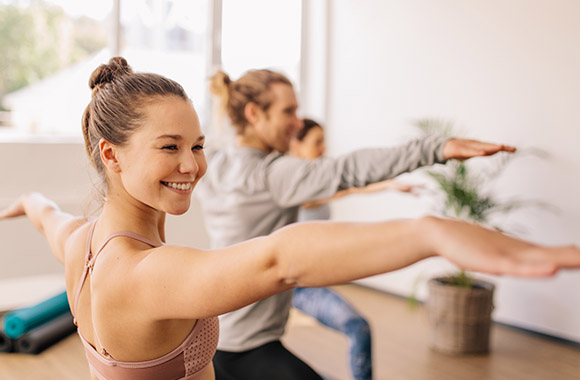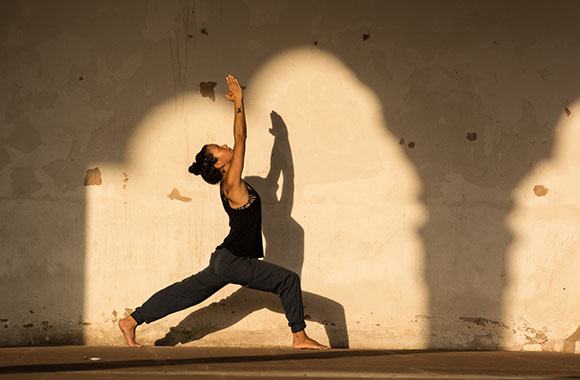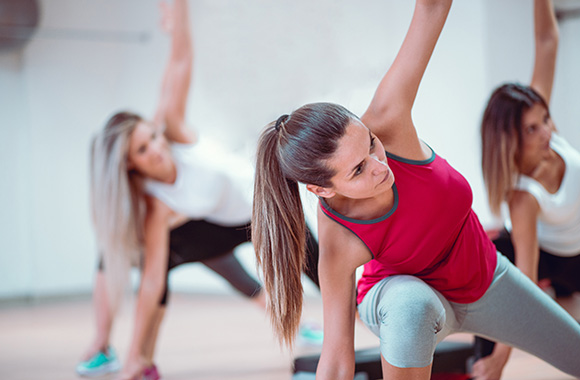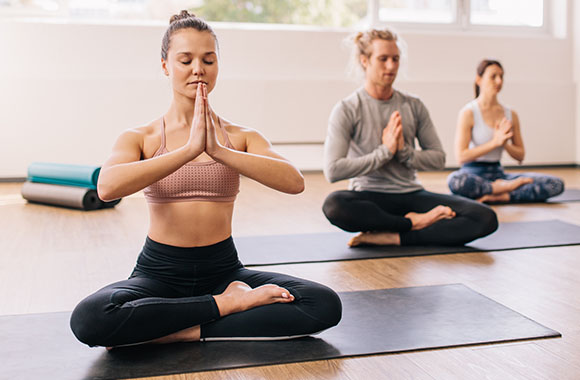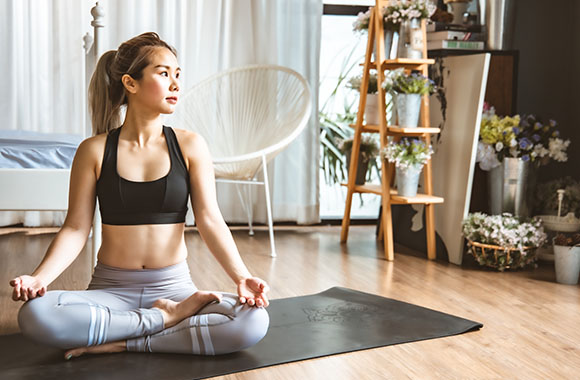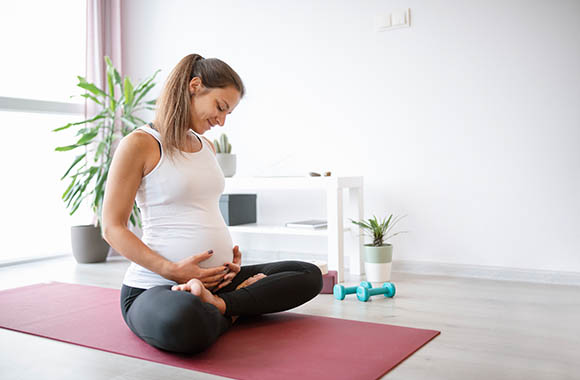Hatha Yoga: Everything about the most popular style of yoga
Hatha yoga is probably the best-known style of yoga and is offered in many yoga classes. Hatha Yoga is built on three pillars: body, breathing, and meditation. When performing the various asanas in Hatha Yoga, you always pay attention to the correct breathing technique and end each yoga practice with a final relaxation. This ensures that you not only strengthen your body but also get to know yourself better and develop an awareness of your body. Hatha Yoga is perfect for beginners. In this article, we explain all the important parts of Hatha Yoga and which other types of yoga are derived from Hatha Yoga.
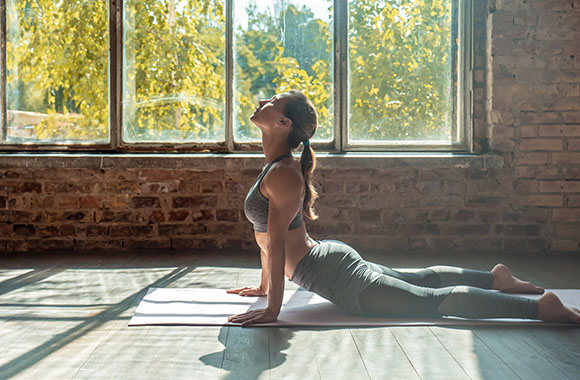
Table of contents
What is Hatha Yoga and who is it suitable for?
Our preconceptions of yoga are mainly based on the principles of Hatha Yoga. It is perfect for beginners as it offers a good introduction to the world of yoga. Hatha Yoga also has many exercises that can be mastered quite easily by beginners. The beauty of classical yoga is that it has a whole range of different asanas that can be adapted to your individual fitness level. So not only can you build up your basic fitness with Hatha Yoga but later you can always seek new challenges with more advanced asanas.
The ancient Sanskrit word Hatha means strength, endurance, and energy. The components of the word “Ha” and “Tha” denote the sun and moon. Symbolically, the word combines the opposing forces of the sky into one.
The ancient Sanskrit word Hatha means strength, endurance, and energy. The components of the word “Ha” and “Tha” denote the sun and moon. Symbolically, the word combines the opposing forces of the sky into one.
The 3 pillars of Hatha Yoga: Exercise for body, mind, and soul
In Hatha Yoga, the human being is regarded as a unity of body, mind, and soul. Therefore, all parts of the yoga practice address these three areas equally. Hatha Yoga consists of asanas (physical exercises), pranayamas (breathing exercises) and shavasana (deep relaxation, meditation).
In the following, we will introduce you to all three pillars of Hatha Yoga in detail:
The physical exercises are designed to strengthen the body, while the breathing exercises and final relaxation aims to help you to focus and find your inner peace.
Physical exercises: the asanas
The asanas strengthen your muscles, tendons, and ligaments. They release tension and release energy. There are different exercises for specific parts of the body. Some postures, such as the “downward dog pose”, stretch your entire spine and shoulders. Other exercises like Pavanamuktasana (“wind relieving pose”) have a positive effect on digestion and the organs. Exercises like Talasana (“palm tree pose”) open your chest which makes breathing easier and the brain is supplied with plenty of oxygen.
Researchers at Wayne State University Detroit found that 20 minutes of Hatha Yoga has a more positive effect on our brainpower than 20 minutes of endurance training.
Researchers at Wayne State University Detroit found that 20 minutes of Hatha Yoga has a more positive effect on our brainpower than 20 minutes of endurance training.
Breathing exercises: the pranayamas
The pranayamas help you to pay attention to your breathing during physical exercise. Which helps more oxygen transfer into your body and the life energy, the prana, is released. We take breathing for granted and often don’t give it a second thought. As a result, we breathe shallowly and unconsciously in our daily lives. We tire much more quickly and feel exhausted because the brain and organs are not supplied with enough oxygen. In Hatha Yoga, you learn to let your breath flow correctly and to use it in a targeted way. This helps you to concentrate better in everyday life and to remain calm in stressful situations.
Meditation: Shavasana
At the end of your yoga session, you should devote 10 to 15 minutes to Shavasana. These are special relaxation exercises that you can do sitting or lying down. They reduce stress hormones, strengthen the immune system, and bring your mind, body, and soul into a state of complete relaxation. If you have less time for your exercises, it is better to do one asana less than to neglect deep relaxation. Shavasana requires a little patience for Hatha Yoga beginners, as not everyone immediately enters the state of relaxation. But from time to time, the effect of relaxation is felt more intensely.
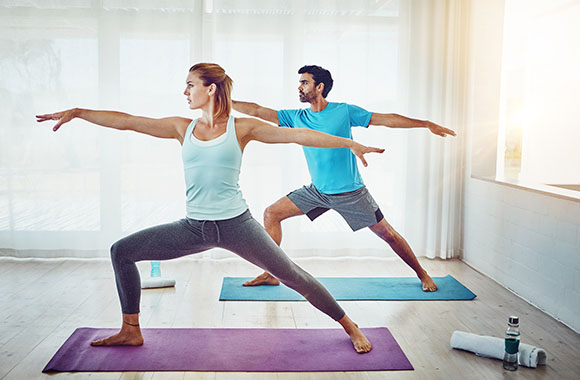
Other components of Hatha Yoga are proper nutrition and a positive attitude. Proper nutrition is not only about eating healthy and sustainable food but also being mindful about it. Eating and drinking should be made an enjoyable and mindful experience. Furthermore, in Hatha Yoga, it is important not to lose a positive attitude towards life. Those who go through life in a positive, friendly, and authentic way are happier and more balanced.
In the teachings of Hatha Yoga, these five basics are intended to ensure more mindfulness and contentment and thus create harmony between mind, body, and soul.
An overview of other types of Hatha Yoga
Many new forms have evolved from Hatha Yoga over the decades, creating a wide variety that offers something for everyone. No matter what your current fitness level and mental strength are – the exercises can be adapted to your own needs to ensure the right balance. Both Hatha Yoga beginners and long-time yogis will find the right style for them.
Iyengar Yoga – Yoga with aids
Iyengar Yoga is a form of Hatha Yoga developed by the yoga master B.S.K. Iyengar. He placed great emphasis on the correct execution of the asanas and the correct posture. Lyengar Yoga is well known for the use of aids such as ropes, blocks, or blankets. These make it possible for both beginners and older people to perform the individual yoga asanas correctly and to experience their positive effects.
You can find more information on powerful and physically more demanding types of yoga in our article „Dynamic yoga“.
In this context, the Charité hospital in Berlin has proven in a study that just 90 minutes of Iyengar yoga per week relieve chronic neck pain better than the well-known, standardised neck exercises.
In this context, the Charité hospital in Berlin has proven in a study that just 90 minutes of Iyengar yoga per week relieve chronic neck pain better than the well-known, standardised neck exercises.
Kundalini Yoga – Spiritual yoga
Kundalini Yoga is the branch of Hatha Yoga that is based primarily on the spiritual teachings of yoga. Kundalini Yoga aims to release energies in the body. Through a combination of breathing exercises, asanas, meditations, and mantras, you not only strengthen your body but also open your mind. Kundalini Yoga is suitable for all those who appreciate the spiritual side of yoga as well as the physical fitness side.
You can find more information on calmer styles of yoga in the article „Yoga for relaxation“.
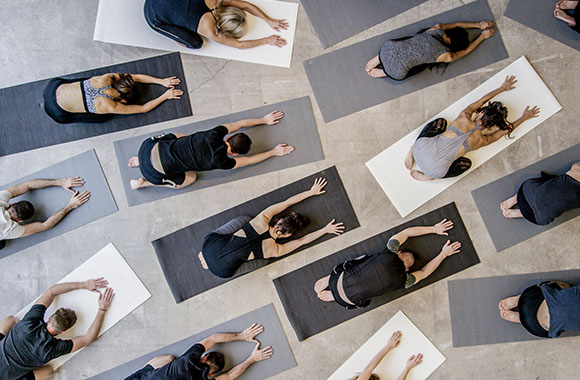
Tao Yin Yoga – Living the Qi
Tao Yin is the Chinese version of Hatha Yoga. It strengthens flexibility, breathing, and the spine. It also stretches your ligaments and puts a special focus on deep relaxation. This type of yoga is a particularly good basis for Tai-Chi, Qigong, and deep, long meditation. It is therefore suitable for all those who are also interested in martial arts or who want to discover the world of meditation for themselves.
You don’t need much for yoga: an open mind, a yoga mat and a comfortable sports outfit.
You don’t need much for yoga: an open mind, a yoga mat and a comfortable sports outfit.
Conclusion
Hatha yoga offers beginners a good introduction to the world of yoga. The combination of physical exercises, breathing techniques, and relaxation exercises typical of Hatha Yoga gives beginners a good idea of how varied yoga can be. But even experienced yogis will always find a new challenge for themselves in the wide range of different asanas. For this reason, Hatha Yoga is the perfect choice for anyone looking for a balanced mix of physical exertion and guided relaxation exercises.
Sources
https://www.mindbodygreen.com/articles/
(accessed on 10.10.2021)
https://isha.sadhguru.org/yoga/
(accessed on 10.10.2021)
https://www.hopkinsmedicine.org/
(accessed on 10.10.2021)
http://www.diss.fu-berlin.de/
(accessed on 10.10.2021)
https://today.wayne.edu/
(accessed on 10.10.2021)
Image sources
iStock.com/Pinkypills
iStock.com/insta_photos
iStock.com/gradyreese
iStock.com/FatCamera

